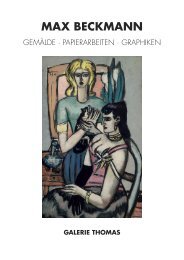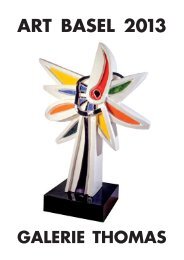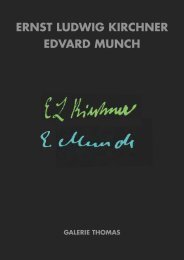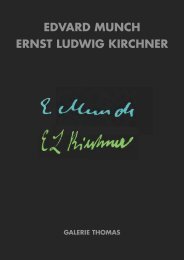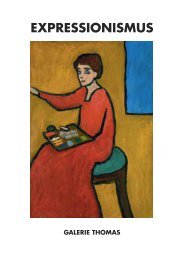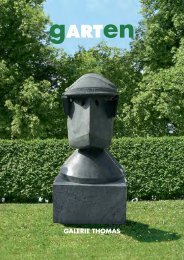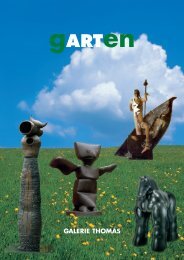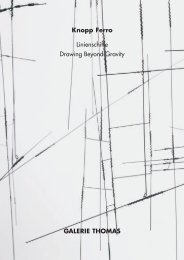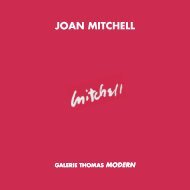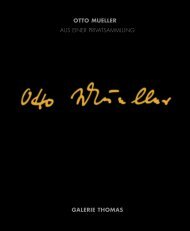Katalog - Galerie Thomas
Katalog - Galerie Thomas
Katalog - Galerie Thomas
Sie wollen auch ein ePaper? Erhöhen Sie die Reichweite Ihrer Titel.
YUMPU macht aus Druck-PDFs automatisch weboptimierte ePaper, die Google liebt.
EDUARDO CHILLIDA<br />
GALERIE THOMAS
Titel / cover<br />
Lurra G 138<br />
Terrakotta / terracotta, 1989<br />
14,5 x 20 x 24,5 cm / 5 2 /3 x 7 3 /4 x 9 2 /3 in.<br />
mit Signet / with signet
EDUARDO CHILLIDA<br />
27. Januar - 24. März 2012<br />
GALERIE THOMAS
„Dank des Raumes gibt es Grenzen in der<br />
physischen Welt, und so kann ich Bildhauer<br />
sein. Nichts wäre möglich, ohne dieses<br />
Anklingen der Grenzen und ohne den Raum,<br />
der sie erlaubt. Welche Art von Raum erlaubt<br />
die Grenzen? Das Universum des Geistes?“<br />
Eduardo Chillida<br />
Eduardo Chillidas Grundthema ist der Raum, der erlebte<br />
oder geahnte. In seinen Arbeiten formuliert er das Verhältnis<br />
von Raum und Licht, die Beziehungen zwischen Körper und<br />
Volumen und Proportion.<br />
Weltbürger und zugleich tief verwurzelt in der Kultur seiner<br />
baskischen Heimat gibt er seinen Werken sehr poetische<br />
Titel, meist in baskischer Sprache. Er fand Inspiration in<br />
der Literatur, Dichtung und Philosophie, in deren Welt er<br />
genauso wie in der Kunst zu Hause war. Eine enge<br />
Freundschaft verband ihn mit Martin Heidegger.<br />
Seit den 1950er Jahren gehört Chillida zu den wichtigsten<br />
Bildhauern seiner Generation. Die zahlreichen Preise und<br />
Ehrungen, mit denen der Künstler für sein Werk ausge -<br />
zeichnet wurde, verdeutlichen seine führende Rolle im Bereich<br />
der internationalen Bildhauerei. So erhielt er 1958 den<br />
Großen Preis für Skulptur auf der Biennale Venedig, 1960<br />
den Kandinsky Preis, 1966 den erstmals verliehenen<br />
Wilhelm Lehmbruck Preis und zusammen mit Willem de<br />
Kooning 1978 den Andrew Mellon Prize. Ab 1959 nahm<br />
er vier Mal an der documenta in Kassel teil. Der ersten<br />
Retrospektive im Jahre 1966 im Museum Fine Arts<br />
Houston – Chillida war gerade 42 Jahre alt – folgten<br />
weitere bedeutende internationale Ausstellungen.<br />
Eduardo Chillida hat zahlreiche Werke für den öffentlichen<br />
Raum geschaffen, unter anderem die monumentale<br />
Skulptur Berlin vor dem Bundeskanzleramt sowie Buscando<br />
la Luz vor der Pinakothek der Moderne in München.<br />
Die letzte Einzelausstellung seiner Werke in der <strong>Galerie</strong><br />
<strong>Thomas</strong> fand 1983 statt. Umso mehr freut es uns, unterschiedliche<br />
Aspekte seines vielschichtigen Œuvres in<br />
unserer aktuellen Ausstellung zu zeigen, die mit Skulpturen,<br />
Zeichnungen, Collagen, den Papierarbeiten der Serie<br />
Gravitaciónes und Graphiken einen Bogen von nahezu<br />
vierzig Jahren spannt.<br />
Heike Grossmann<br />
”Thanks to space, there are limits in the<br />
physical world, and so I can be a sculptor.<br />
Nothing would be possible without this inkling<br />
of limits, and without the space which allows them<br />
to exist. What kind of space allows limits?<br />
The universe of the spirit?”<br />
Eduardo Chillida<br />
Eduardo Chillida’s key theme is space, the experience or<br />
inkling of space. His works formulate the relationship between<br />
space and light, between solid bodies, volumes and<br />
proportions.<br />
A cosmopolitan man who was nevertheless deeply rooted in<br />
the culture of his native Basque Country, Chillida gave his<br />
works deeply poetic titles, most of them in Basque. He drew<br />
inspiration from literature, poetry and philosophy – a world in<br />
which he felt just as much at home as he did in art. He was a<br />
close friend of Martin Heidegger.<br />
Chillida has counted among the most important sculptors of his<br />
generation ever since the nineteen-fifties. The countless prizes<br />
and honours he has received for his work attest to his pioneering<br />
role in the development of sculpture worldwide. After winning<br />
the Grand Prix for Sculpture at the Venice Biennale 1958,<br />
he was awarded the Kandinsky Prize two years later, the first<br />
ever Wilhelm Lehmbruck Prize in 1966, and the Andrew Mellon<br />
Prize, which he shared with Willem de Kooning, in 1978.<br />
Chillida took part in four documentas in Kassel, the first of them<br />
in 1959, and was accorded his first retrospective by the<br />
Museum of Fine Arts in Houston in 1966, aged just forty-two.<br />
Several major international exhibitions followed.<br />
Eduardo Chillida created numerous works for the public space,<br />
among them the monumental work Berlin (2000), which stands<br />
in front of the German Chancellery in the city of that name, and<br />
Buscando la Luz (1997) in front of the Pinakothek der Moderne<br />
in Munich.<br />
The last solo exhibition of Chillida’s works at the <strong>Galerie</strong><br />
<strong>Thomas</strong> was in 1983. We are therefore all the more delighted<br />
to have this opportunity of presenting various aspects of his<br />
highly complex oeuvre in the present exhibition, which includes<br />
sculptures, drawings, collages, prints and the works on paper<br />
from the Gravitaciónes series, covering a time span of<br />
nearly forty years.
Gravitación<br />
Collage mit handgefertigtem Paperki Papier mit Schnur / collage with handmade Paperki paper with string, 1994<br />
22,3 x 31,5 cm / 8 3 /4 x 12 3 /8 in.<br />
signiert und mit Signet unten rechts / signed and with signet lower right<br />
4
„Ich stelle nichts dar, ich frage.“<br />
”I do not represent, I ask.”<br />
Lurra<br />
Terrakotta / terracotta, 1997<br />
19 x 20 x 22 cm / 7 1 /2 x 7 7 /8 x 8 5 /8 in.<br />
mit Signet / with signet<br />
6
„Ist nicht die Begrenzung die wahre Protagonistin des Raumes,<br />
so wie die Gegenwart, eine andere Grenze,<br />
die Protagonistin der Zeit ist?“<br />
”Is not the limit the true protagonist of space,<br />
just as the present, another limit,<br />
is the protagonist of time?”<br />
Lurra M-13<br />
Terrakotta / terracotta, 1995<br />
27 x 22 x 21 cm / 10 5 /8 x 8 5 /8 x 8 1 /4 in.<br />
mit Signet / with signet<br />
8
Gravitación<br />
Tinte auf Papier-Collage mit Schnur / ink on paper collage with string, 1988<br />
59,1 x 79,4 cm / 23 1 /4 x 31 1 /4 in.<br />
signiert und mit Signet unten Mitte / signed and with signet lower center<br />
10
Fieltro<br />
Wollfilz und Tusche / felt and ink, 1997<br />
91 x 69,5 cm / 35 7 /8 x 27 3 /8 in.<br />
mit Signet Mitte rechts / with signet center right<br />
11
„Ist die Kunst nicht die Folge einer Notwendigkeit<br />
– schön und schwierig zugleich –<br />
die uns zu dem Versuch treibt, etwas zu machen, ohne zu wissen wie?“<br />
”Might art not be a consequence<br />
of a beautiful and difficult need<br />
that leads us to try to do something we know not how to do?”<br />
Lurra G 122<br />
Terracotta / terracotta, 1989<br />
23 x 14 x 23 cm / 9 x 5 1 /2 x 9 in.<br />
mit Signet / with signet<br />
12
Collage beige<br />
Papier-Collage / paper collage, c. 1980<br />
31,6 x 23,7 cm / 12 3 /8 x 9 3 /8 in.<br />
signiert und mit Signet unten links / signed and with signet lower left<br />
14
Collage beige<br />
Papier-Collage / paper collage<br />
13,5 x 20,5 cm / 5 1 /3 x 8 in.<br />
signiert und mit Signet unten rechts / signed and with signet lower right<br />
15
„Im Morgengrauen wußte ich,<br />
wie das Werk werden muß.<br />
Es gibt tausend Möglichkeiten und doch nur eine.“<br />
”At the break of dawn, I knew<br />
what the work was going to be like.<br />
It might be in thousand forms, yet only in one.”<br />
Lurra G 221<br />
Terrakotta / terracotta, 1991<br />
24,5 x 18 x 16,5 cm / 9 2 /3 x 7 x 6 1 /2 in.<br />
mit Signet / with signet<br />
16
Collage<br />
Tinte auf Papier-Collage / ink on paper collage, 1981<br />
20 x 13,5 cm / 7 7 /8 x 5 3 /8 in.<br />
signiert und mit Signet unten rechts / signed and with signet lower right<br />
18
Dibujo tinta (Mano)<br />
Tusche auf Papier / ink on paper<br />
17 x 13,1 cm / 6 2 /3 x 5 1 /8 in.<br />
signiert und mit Signet unten links / signed and with signet lower left<br />
19
20<br />
Antzo II<br />
Radierung auf Rives / etching on Rives paper, 1985<br />
32,5 x 22,5 cm / 12 3 /4 x 8 7 /8 in.<br />
signiert, mit Signet und numeriert 72/111<br />
signed, with signet and numbered<br />
Auflage / edition 111 plus 14<br />
van der Koelen 85003<br />
Zubi-Aundi<br />
Aquatinta auf Bütten / aquatint on laid paper, 1989<br />
160 x 123 cm / 63 x 48 3 /8 in.<br />
signiert, mit Signet, bezeichnet H.C.<br />
signed, with signet and inscribed<br />
Auflage / edition 50 plus 18<br />
van der Koelen 89011<br />
Menturatu<br />
Aquatinta auf Bütten / aquatint on laid paper, 1991<br />
50,5 x 65,5 cm / 19 7 /8 x 25 3 /4 in.<br />
signiert, mit Signet und numeriert 48/50<br />
signed, with signet and numbered<br />
Auflage / edition 50 plus 16<br />
van der Koelen 01002
Aus: Aischylos – Die Perser<br />
Holzschnitt auf Bütten / woodcut on laid paper, 1978<br />
30,5 x 20,5 cm / 12 x 8 in.<br />
signiert, mit Signet und numeriert 12/50<br />
signed, with signet and numbered<br />
Auflage / edition 50 plus 10<br />
van der Koelen 78004<br />
Batzar<br />
Radierung auf Papier / etching on paper, 1983<br />
20 x 14 cm / 7 7 /8 x 5 1 /2 in.<br />
signiert, mit Signet und numeriert 5/50<br />
signed, with signet and numbered<br />
Auflage / edition 50 plus 11<br />
van der Koelen 83002<br />
Batz<br />
Radierung auf Segundo Santos Papier, 1984<br />
etching on Segundo Santos paper<br />
20 x 16,5 cm / 7 7 /8 x 6 1 /2 in.<br />
signiert, mit Signet und numeriert ‘XXI/XXV’<br />
signed, with signet and numbered<br />
Auflage / edition XXV plus 15 plus 67 on Rives<br />
van der Koelen 84004<br />
21
Eduardo Chillida<br />
1924 Geboren am 10. Januar in San Sebastián im spanischen<br />
Baskenland als Sohn eines Berufsoffiziers und einer<br />
Sopranistin.<br />
1943-46 Architekturstudium an der Universität von Madrid.<br />
1947 Abbruch des Architekturstudiums und Besuch der<br />
Kunstakademie in Madrid.<br />
1948 Umzug nach Paris; erste Figuren in Gips entstehen.<br />
1949 Teilnahme am Salon de Mai in Paris, Chillida zeigt<br />
seine Gipsfigur Forma.<br />
1950 Heirat mit Pilar de Belzunce, Umzug nach Villaines-sur-<br />
Bois bei Paris. Geburt des ersten von acht Kindern.<br />
1951 Rückkehr nach Hernani bei San Sebastián.<br />
Beim Transport aus Frankreich Beschädigung bzw.<br />
Zerstörung der meisten seiner Werke. Entscheidung zum<br />
künstlerischen Neubeginn. In der örtlichen Schmiede<br />
entsteht die erste abstrakte Eisenskulptur.<br />
1954 Erste Einzelausstellung in der Galería Clan in Madrid;<br />
erster öffentlicher Auftrag: vier Eisentüren für den<br />
Haupteingang der Basilika in Aránzazu im Baskenland.<br />
Beteiligung am ‘Premier Salon de la Sculpture Abstraite’<br />
der <strong>Galerie</strong> Denise René in Paris.<br />
Chillida erhält das Ehrendiplom der X. Triennale in<br />
Mailand.<br />
1956 Erste größere Einzelausstellung in der <strong>Galerie</strong> Maeght in<br />
Paris; in der Folge dort regelmäßige Ausstellungen.<br />
1957 Umzug in die Villa Paz in San Sebastián, Einrichtung<br />
einer Schmiede am Haus.<br />
1958 Erste USA-Reise. Bekanntschaft mit dem Architekten Frank<br />
Lloyd Wright.<br />
Großer Internationaler Preis für Skulptur auf der<br />
29. Biennale in Venedig.<br />
1959 Erste Arbeiten in Holz, erste Werke aus Stahl und erste<br />
Radierungen.<br />
Teilnahme an der documenta II. Beginn einer intensiven<br />
Rezeption von Chillidas Werk in Deutschland.<br />
1960 Erste Beteiligung an einer Ausstellung in den USA: ‘New<br />
Spanish Painting and Sculpture’ im Museum of Modern<br />
Art in New York. Teilnahme an der Biennale in Venedig.<br />
Bekanntschaft und Beginn der Freundschaft mit Alberto<br />
Giacometti.<br />
1962 Reise nach London, um den Parthenonfries im British<br />
Museum zu sehen; erste Arbeit in Marmor; reist bald<br />
darauf nach Griechenland. Aussstellung ‘Three<br />
Spaniards: Picasso, Miró, Chillida’ im Museum of Fine<br />
Arts in Houston, Texas.<br />
1964 Teilnahme an der documenta III in Kassel und der<br />
Ausstellung ‘Paintings and Sculpture of a Decade 54-64’<br />
in der Tate Gallery in London. Chillida erhält den<br />
Carnegie-Preis für Skulptur.<br />
1965 Erste Arbeiten in Alabaster.<br />
22<br />
1924 born 10 January in San Sebastián in Spain’s<br />
Basque Country to an army officer and a soprano.<br />
1943–46 studies architecture at the University of Madrid.<br />
1947 abandons architecture and enrolls at the Art<br />
Academy in Madrid.<br />
1948 moves to Paris; makes first figures in plaster.<br />
1949 participates in the Salon de Mai in Paris; exhibits<br />
his plaster figure Forma.<br />
1950 marries Pilar de Belzunce and moves to<br />
Villaines-sur-Bois near Paris. Birth of the first of eight<br />
children.<br />
1951 returns to Hernani near San Sebastián. Most of his<br />
works are either damaged or destroyed in transit<br />
from France. Decision to start afresh. Makes first<br />
abstract iron sculptures at the local forge.<br />
1954 first solo exhibition at the Galería Clan in Madrid;<br />
first public commission: four iron gates for the main<br />
entrance of the Basilica at Arántzazu in the Basque<br />
Country.<br />
Takes part in the ‘Premier Salon de la Sculpture<br />
Abstraite’ at the <strong>Galerie</strong> Denise René in Paris.<br />
The 10 th Milan Triennale awards Chillida an<br />
honorary diploma.<br />
1956 First major solo exhibition at the <strong>Galerie</strong> Maeght<br />
in Paris, where he will henceforth be a regular<br />
exhibitor.<br />
1957 Moves to the Villa Paz in San Sebastián and builds<br />
a forge onto the house.<br />
1958 First trip to the USA where he meets the architect<br />
Frank Lloyd Wright.<br />
Wins the Grand Prix for Sculpture at the 29 th Venice<br />
Biennale.<br />
1959 First works in wood, first works in steel, first<br />
etchings. Takes part in documenta II. Chillida’s work<br />
begins to attract critical engagement in Germany.<br />
1960 For the first time participates in a group show in the<br />
USA: ‘New Spanish Painting and Sculpture’ at the<br />
Museum of Modern Art in New York. Participates in<br />
the Venice Biennale. Meets and becomes friends<br />
with Alberto Giacometti.<br />
1962 Travels to London to see the Parthenon Frieze at the<br />
British Museum; first works in marble, visits Greece<br />
soon afterwards. Exhibition: ‘Three Spaniards:<br />
Picasso, Miró, Chillida’ at the Museum of Fine Arts<br />
in Houston, Texas.<br />
1964 Takes part in documenta III in Kassel and the<br />
exhibition ‘Paintings and Sculpture of a Decade<br />
54–64’ at the Tate Gallery in London. Chillida is<br />
awarded the Carnegie Prize for Sculpture.<br />
1965 First works in alabaster.
1966 Einzelausstellung im Wilhelm-Lehmbruck-Museum in<br />
Duisburg. Die erste monumentale Steinskulptur entsteht.<br />
Erste Retrospektive in den USA in Houston, Texas.<br />
Teilnahme an der documenta IV in Kassel.<br />
Erste Begegnung mit Martin Heidegger, mit dem ihn<br />
bald eine Freundschaft verbindet. Chillida erhält den<br />
erstmalig vergebenen Wilhelm-Lehmbruck-Preis und den<br />
Preis des Landes Nordrhein-Westfalen.<br />
1969 Einzelausstellungen im Stedelijk Museum, Amsterdam<br />
und dem Kunsthaus Zürich.<br />
1971 Mehrmonatige Gastprofessur an der Harvard University<br />
in Cambridge, Mass.<br />
Ernennung zum Mitglied der Akademie der Bildenden<br />
Künste in München.<br />
1977 Teilnahme an der documenta VI in Kassel.<br />
Einweihung der drei Skulpturen Peine del viento<br />
(Windkamm) an der Bucht von San Sebastián.<br />
1979/80 Große Retrospektive im Carnegie Institute des<br />
Pittburgh Museum of Art und in der National Gallery in<br />
Washington. Ein Teil davon reist ins Solomon R.<br />
Guggenheim Museum in New York, anschließend<br />
nach Madrid und Bilbao.<br />
1982 Umzug auf den Monte Igueldo in San Sebastián. Kauf<br />
eines alten Bauernhauses in Zabalaga bei Hernani.<br />
1983 Ernennung zum Mitglied der Royal Academy of Arts in<br />
London. Prix Européen des Arts Plastiques in Straßburg.<br />
1984 Gründung der Chillida-Stiftung. In Zabalaga sollen<br />
Dokumente, Photographien und Werke aus dem Besitz<br />
der Familie gesammelt werden.<br />
1985 ‘Kaiserring’ der Stadt Goslar für Chillida.<br />
1986 Auftrag der baskischen Stadt Guernica für ein<br />
Monument anläßlich des 50. Jahrestages der<br />
Zerstörung der Stadt im Spanischen Bürgerkrieg.<br />
1989 Installation der Stahlskulptur Zuhaitz (Baum) in<br />
Grenoble, vom französischen Kulturminister aus Anlaß<br />
des 200. Jahrestages der Französischen Revolution in<br />
Auftrag gegeben.<br />
1990 Reise nach Japan.<br />
Auf der 44. Biennale von Venedig Sonderausstellung<br />
‘Hommage an Eduardo Chillida’.<br />
1991 Retrospektive im Neuen Berliner Kunstverein im<br />
Martin-Gropius-Bau.<br />
1996 Thematische Ausstellung ‘Chillida und Goethe’ im<br />
Kulturgeschichtlichen Museum Osnabrück, Akzisehaus.<br />
1998 Umfassende Retrospektive im Museo Reina Sofía in<br />
Madrid, die im Jahr darauf im Guggenheim Museum<br />
Bilbao gezeigt wird.<br />
2000 Eröffnung des Museums ‘Chillida Leku’ (Chillidas Ort) in<br />
einem Bauernhof aus dem 16. Jahrhundert in Hernani<br />
bei San Sebastián.<br />
Im Oktober Enthüllung der Monumentalskulptur Berlin<br />
vor dem deutschen Kanzleramt.<br />
2002 Eduardo Chillida stirbt am 19. August in seinem Haus<br />
in San Sebastián.<br />
23<br />
1966 Solo exhibition at the Wilhelm Lehmbruck Museum in<br />
Duisburg. First monumental stone sculpture. First retrospective<br />
in den USA, in Houston, Texas. Takes part in<br />
documenta IV in Kassel.<br />
First encounter with Martin Heidegger, who will soon<br />
become a firm friend. Chillida becomes the first artist to<br />
receive the Wilhelm Lehmbruck Prize and the Prize of<br />
the State of North Rhine-Westphalia.<br />
1969 Solo exhibitions at the Stedelijk Museum, Amsterdam<br />
and at Kunsthaus Zürich.<br />
1971 Several months as guest professor at Harvard University<br />
in Cambridge, Mass.<br />
Elected an academician of the Academy of Fine Arts,<br />
Munich.<br />
1977 Takes part in documenta VI in Kassel.<br />
Unveiling of the three sculptures Peine del Viento<br />
(Wind Comb), in the bay of San Sebastián.<br />
1979/80 Major retrospective at the Carnegie Institute of the<br />
Pittburgh Museum of Art and at the National Gallery in<br />
Washington. Part of this travels to the Solomon R.<br />
Guggenheim Museum in New York, then to Madrid<br />
and Bilbao<br />
1982 Move to Monte Igueldo in San Sebastián. Chillida<br />
buys an old farmhouse in Zabalaga near Hernani.<br />
1983 Elected an academician of the Royal Academy of Arts<br />
in London. Receives the Prix Européen des Arts<br />
Plastiques in Strasbourg.<br />
1984 Founding of the Chillida Foundation. Documents,<br />
photographs and works belonging to the family are<br />
henceforth to be kept together in Zabalaga.<br />
1985 Chillida wins the ‘Kaiserring’ of Goslar.<br />
1986 The Basque town of Guernica commissions a<br />
monument to mark the 50th anniversary of the<br />
destruction of the city during the Spanish Civil War.<br />
1989 Installation of Zuhaitz (Tree) in Grenoble, a steel<br />
sculpture commissioned by the French Minister of Culture<br />
to mark the bicentenary of the French Revolution.<br />
1990 Visits Japan.<br />
Special exhibition ‘Homage to Eduardo Chillida’ held<br />
at the 44th Venice Biennale.<br />
1991 Retrospective by the Neue Berliner Kunstverein at the<br />
Martin-Gropius-Bau.<br />
1996 Special theme show ‘Chillida und Goethe’ at the<br />
Kulturgeschichtliches Museum Osnabrück, Akzisehaus.<br />
1998 Comprehensive retrospective at the Museo Reina Sofía<br />
in Madrid, which a year later will be shown at the<br />
Guggenheim Museum Bilbao.<br />
2000 Opening of the museum ‘Chillida Leku’ (Chillida’s<br />
Place) in a 16 th -century farmhouse in Hernani near San<br />
Sebastián.<br />
Unveiling of the monumental sculpture Berlin in front of the<br />
German Chancellery in Berlin in October of that year.<br />
2002 Eduardo Chillida dies on August 19 at his home in San<br />
Sebastián.
IMPRESSUM<br />
Preise auf Anfrage.<br />
Es gelten unsere Lieferungs- und Zahlungsbedingungen.<br />
Maße: Höhe vor Breite vor Tiefe.<br />
<strong>Katalog</strong> 121<br />
© <strong>Galerie</strong> <strong>Thomas</strong> 2012<br />
© Zabalaga-Leku / VG Bild-Kunst, Bonn 2012<br />
Zitate von Chillida entnommen aus:<br />
Bussmann, Klaus. Chillida. Hauptwerke. Mainz/München 2003<br />
<strong>Katalog</strong>bearbeitung:<br />
Heike Grossmann, Bettina Beckert, Patricia von Eicken<br />
Übersetzung:<br />
Bronwen Saunders (S. 3, 22, 23)<br />
Photographie<br />
Walter Bayer (S. 9)<br />
J. Jesús Blázquez (S. 5,7)<br />
Dorothea van der Koelen (S. 2)<br />
<strong>Katalog</strong>produktion:<br />
Vera Daume<br />
Layout:<br />
Sabine Urban, Gauting<br />
Lithos:<br />
Reproline mediateam GmbH + Co. KG, München<br />
Druck:<br />
SDM, Stulz-Druck & Medien GmbH, München<br />
Mo - Fr 9-18 · Sa 10 -14<br />
Maximilianstrasse 25 · 80539 München· Germany<br />
Telefon +49-89-29 000 80 · Telefax +49-89-29 000 888<br />
info@galerie-thomas.de · www.galerie-thomas.de<br />
GALERIE THOMAS<br />
PUBLICATION DETAILS<br />
Prices upon request.<br />
We refer to our sales and delivery conditions.<br />
Measurements: height by width by depth.<br />
Catalogue 121<br />
© <strong>Galerie</strong> <strong>Thomas</strong> 2012<br />
© Zabalaga-Leku / VG Bild-Kunst, Bonn 2012<br />
Quotes by chillida from:<br />
Bussmann, Klaus. Chillida. Hauptwerke. Mainz/Munich 2003<br />
Catalogue editing:<br />
Heike Grossmann, Bettina Beckert, Patricia von Eicken<br />
Translation:<br />
Bronwen Saunders (p. 3, 22,23)<br />
Photography<br />
Walter Bayer (p. 9)<br />
J. Jesús Blázquez (p. 5,7)<br />
Dorothea van der Koelen (p. 2)<br />
Catalogue production:<br />
Vera Daume<br />
Design:<br />
Sabine Urban, Gauting<br />
Colour Separations:<br />
Reproline mediateam GmbH + Co. KG, Munich<br />
Printing:<br />
SDM, Stulz-Druck & Medien GmbH, Munich
GALERIE THOMAS



